Amplified Eastward SAPS Flows Observed in the Topside Ionosphere near Magnetic Midnight
Abstract
1. Introduction
1.1. Subauroral Plasma Flows and Their Generation Mechanisms
1.2. Plasma Convection
1.3. Polar Convection EDawn-Dusk Field Driving the Plasma at Subauroral and Mid Latitudes
1.4. Hypothesis and Aim of This Study
2. Materials and Methods
3. Results
3.1. Dawn-Cell-Associated Amplified Eastward SAPS Observed by F15 near Magnetic Midnight
3.2. Underlying Interplanetary and Geophysical Conditions
3.3. Sunward Streaming Amplified Eastward SAPS Flow: 7 October 2015 Event
3.4. Antisunward Streaming Amplified Eastward SAPS Flow: 3 March 2015 Event
3.5. Correlated F15 and TH-E Observations of 8 September 2015 Event
4. Summary of New Results
5. Discussion
6. Conclusions
Supplementary Materials
Author Contributions
Funding
Institutional Review Board Statement
Informed Consent Statement
Data Availability Statement
Acknowledgments
Conflicts of Interest
Glossary
| SAPS E field | Develops in the inner magnetosphere and drives the subauroral polarization streams (SAPSs) in the ionosphere. |
| Dawn-dusk convection E field | Refers to the large-scale electric field within the magnetosphere, driven by the solar wind’s interaction with the Earth’s magnetic field, which causes charged particles to convect or move. |
| Polar convection E field | Refers to the electric field in Earth’s polar regions ultimately driven by the solar wind’s interaction with the magnetosphere. |
| Equatorward polar convection E field | Refers to the mapped-down inward-directed magnetotail-reconnection-related cross-tail convection E field. |
| Polerward polar convection E field | Refers to the mapped-down outward-directed magnetopause-reconnection-related convection E field. |
| Prompt penetration electric field (PPEF) | Refers to an almost instantaneous, rapid penetration of electric fields from the Earth’s high-latitude ionosphere to the equatorial ionosphere. |
Abbreviations
| B field | Magnetic Field |
| CG | Current Generator |
| DMSP | Defense Meteorological Satellite Program |
| E field | Electric Field |
| EC | Convection Electric Field |
| EDawn-Dusk | Dawn-to-Dusk E Field |
| EDusk-Dawn | Dusk-to-Dawn E Field |
| EPIC | Energetic Particle and Ion Composition |
| EPS | Energetic Particle Sensor |
| EFI | Electric Field Instrument |
| ESA | Electrostatic Analyzer |
| FACs | Field-Aligned Currents |
| GLAT | Geographic Latitude |
| GLON | Geographic Longitude |
| GMOM | Ground-Calculated Moments |
| GOES | Geostationary Operational Environmental Satellites |
| GSE | Geocentric Solar Ecliptic |
| GSM | Geocentric Solar Magnetospheric |
| H-M | Heppner–Maynard |
| L | L Shell |
| M-I | Magnetosphere–Ionosphere |
| MIT | Main Ionospheric Trough |
| MLAT | Magnetic Latitude |
| MLT | Magnetic Local Time |
| Ne | Electron Density |
| Pe | Electron Pressure |
| Pi | Ion Pressure |
| PJ | Polarization Jet |
| PP | Plasmapause |
| PPEF | Prompt Penetration Electric Field |
| RIT | Ring-Current-Related Ionospheric Trough |
| R1 | Region 1 |
| R2 | Region 2 |
| SAID | Subauroral Ion Drifts |
| SAPS | Subauroral Polarization Streams |
| SC Pot | Spacecraft Potential |
| SCW | Substorm Current Wedge |
| SCW2L | Substorm Current Wedge 2-Loop |
| SSUSI | Special Sensor Ultraviolet Spectrographic Imager |
| SuperDARN | Super Dual Auroral Radar Network |
| Te | Electron Temperature |
| THEMIS | Time History of Events and Macroscale Interactions during Substorms |
| TB | Trapping Boundary |
| Ti | Ion Temperature |
| Ve | Electron Drift |
| VG | Voltage Generator |
| VGFT | Fast-Time Voltage Generator |
| VGM | Magnetospheric Voltage Generator |
| VHOR | Cross-Track Horizontal Drift Velocity |
| VVER | Cross-Track Vertical Drift Velocity |
| WTS | Westward Traveling Surge |
References
- Foster, J.; Burke, W. A new categorization for sub-auroral electric fields. Eos. Trans. Am. Geophys. Union 2002, 83, 393–394. [Google Scholar] [CrossRef]
- Spiro, R.W.; Heelis, R.A.; Hanson, W.B. Rapid subauroral drifts observed by Atmosphere Explorer C. Geophys. Res. Lett. 1979, 6, 657–660. [Google Scholar] [CrossRef]
- Galperin Yu, L.; Ponomarev, V.N.; Zosimova, A.G. Plasma convection in the polar ionosphere. Ann. Geophys. 1974, 30, 1–7. [Google Scholar]
- Smiddy, M.; Kelley, M.C.; Burke, W.; Rich, F.; Sagalyn, R.; Shuman, B.; Hays, R.; Lai, S. Intense poleward-directed electric fields near the ionospheric projection of the plasmapause. Geophys. Res. Lett. 1977, 4, 543–546. [Google Scholar] [CrossRef]
- Maynard, N.; Aggson, T.; Heppner, J. Magnetospheric observation of large subauroral electric fields. Geophys. Res. Lett. 1980, 7, 881–884. [Google Scholar] [CrossRef]
- Karlsson, T.; Marklund, G.T.; Blomberg, L.G.; Mälkki, A. Subauroral electric fields observed by the Freja satellite: A statistical study. J. Geophys. Res. 1998, 103, 4327–4341. [Google Scholar] [CrossRef]
- Foster, J.C.; Vo, H.B. Average characteristics and activity dependence of the subauroral polarization stream. J. Geophys. Res. 2002, 107, SIA 16-1–SIA 16-10. [Google Scholar] [CrossRef]
- Anderson, P.C.; Heelis, R.A.; Hanson, W.B. The ionospheric signatures of rapid subauroral ion drifts. J. Geophys. Res. 1991, 96, 5785–5792. [Google Scholar] [CrossRef]
- Anderson, P.C.; Hanson, W.B.; Heelis, R.A.; Craven, J.D.; Baker, D.N.; Frank, L.A. A proposed production model of rapid subauroral ion drifts and their relationship to substorm evolution. J. Geophys. Res. 1993, 98, 6069–6078. [Google Scholar] [CrossRef]
- Horvath, I.; Lovell, B.C. Investigating the Coupled Magnetosphere-Ionosphere-Thermosphere (M-I-T) System’s Responses to the 20 November 2003 Superstorm. J. Geophys. Res. Space Phys. 2021, 126, e2021JA029215. [Google Scholar] [CrossRef]
- Horvath, I.; Lovell, B.C. Multi-point satellites observed dawnside Subauroral Polarization Streams (SAPS) developed on a short timescale under weak-storm and non-storm substorm conditions. J. Geophys. Res. Space Phys. 2025, 130, e2025JA033755. [Google Scholar] [CrossRef]
- Makarevich, R.A.; Kellerman, A.C.; Bogdanova, Y.V.; Koustov, A.V. Time evolution of the subauroral electric fields: A case study during a sequence of two substorms. J. Geophys. Res. 2009, 114, A04312. [Google Scholar] [CrossRef]
- Southwood, D.; Wolf, R. An assessment of the role of precipitation in magnetospheric convection. J. Geophys. Res. 1978, 83, 5227–5232. [Google Scholar] [CrossRef]
- Mishin, E.V. The evolving paradigm of the subauroral geospace. Front. Astron. Space Sci. 2023, 10, 1118758. [Google Scholar] [CrossRef]
- Mishin, E.V. Interaction of substorm injections with the subauroral geospace: 1. Multispacecraft observations of SAID. J. Geophys. Res. Space Phys. 2013, 118, 5782–5796. [Google Scholar] [CrossRef]
- Mishin, E.V. SAPS onset timing during substorms and the westward traveling surge. Geophys. Res. Lett. 2016, 43, 6687–6693. [Google Scholar] [CrossRef]
- Mishin, E.; Nishimura, Y.; Foster, J. SAPS/SAID revisited: A causal relation to the substorm current wedge. J. Geophys. Res. Space Phys. 2017, 122, 8516–8535. [Google Scholar] [CrossRef]
- Sergeev, V.A.; Nikolaev, A.V.; Tsyganenko, N.A.; Angelopoulos, V.; Runov, A.V.; Singer, H.J.; Yang, J. Testing a two-loop pattern of the substorm current wedge (SCW2L). J. Geophys. Res. 2014, 119, 947–963. [Google Scholar] [CrossRef]
- Ohtani, S.; Gjerloev, J.W.; Anderson, B.J.; Kataoka, R.; Troshichev, O.; Watari, S. Dawnside wedge current system formed during intense geomagnetic storms. J. Geophys. Res. Space Phys. 2018, 123, 9093–9109. [Google Scholar] [CrossRef]
- Ohtani, S.; Sorathia, K.; Merkin, V.G.; Frey, H.U.; Gjerloev, J.W. External and internal causes of the stormtime intensification of the dawnside westward auroral electrojet. J. Geophys. Res. Space Phys. 2023, 128, e2023JA031457. [Google Scholar] [CrossRef]
- Akasofu, S.I. The dynamical morphology of the aurora polaris. J. Geophys. Res. 1963, 68, 1667–1673. [Google Scholar] [CrossRef]
- Akasofu, S.-I. The development of the auroral substorm. Planet. Space Sci. 1964, 12, 273–282. [Google Scholar] [CrossRef]
- Huang, C.; Zhang, Y.; Wang, W.; Lin, D.; Wu, Q. Low-latitude zonal ion drifts and their relationship with subauroral polarization streams and auroral return flows during intense magnetic storms. J. Geophys. Res. Space Phys. 2021, 126, e2021JA030001. [Google Scholar] [CrossRef]
- Lin, D.; Wang, W.; Merkin, V.G.; Huang, C.; Oppenheim, M.; Sorathia, K.; Pham, K.; Michael, A.; Bao, S.; Wu, Q. Origin of Dawnside Subauroral Polarization Streams During Major Geomagnetic Storms. AGU Adv. 2022, 3, e2022AV000708. [Google Scholar] [CrossRef]
- Aa, E.; Zhang, S.-R.; Wang, W.; Erickson, P.J.; Coster, A.J. Multiple longitude sector storm-enhanced density (SED) and long-lasting subauroral polarization stream (SAPS) during the 26–28 February 2023 geomagnetic storm. J. Geophys. Res. Space Phys. 2023, 128, e2023JA031815. [Google Scholar] [CrossRef]
- Qian, C.; Wang, H.A. Statistical Study of Ion Upflow during Periods of Dawnside Auroral Polarization Streams and Subauroral Polarization Streams. Remote Sens. 2023, 15, 1320. [Google Scholar] [CrossRef]
- Lin, D.; Wang, W.; Fok, M.-C.; Pham, K.; Yue, J.; Wu, H. Subauroral red arcs generated by inner magnetospheric heat flux and by subauroral polarization streams. Geophys. Res. Lett. 2024, 51, e2024GL109617. [Google Scholar] [CrossRef]
- Sun, Y.; Wang, H.; Zhang, K. Impact of interplanetary magnetic field By on subauroral polarization streams at dawn and dusk. J. Geophys. Res. Space Phys. 2024, 129, e2024JA033063. [Google Scholar] [CrossRef]
- Mishin, E.V.; Streltsov, A.V. Toward the unified theory of SAID-linked subauroral arcs. J. Geophys. Res. Space Phys. 2024, 129, e2023JA032196. [Google Scholar] [CrossRef]
- Dungey, J.W. Interplanetary magnetic field and the auroral zones. Phys. Rev. Lett. 1961, 6, 47–48. [Google Scholar] [CrossRef]
- Johnson, F.S. The driving force for magnetospheric convection. Rev. Geophys. 1978, 16, 161–167. [Google Scholar] [CrossRef]
- Brice, N.M. Bulk motion of the magnetosphere. J. Geophys. Res. 1967, 72, 5193–5211. [Google Scholar] [CrossRef]
- Nishida, A. Formation of plasmapause, or magnetospheric plasma knee, by the combined action of magnetospheric convection and plasma escape from the tail. J. Geophys. Res. 1966, 71, 5669–5679. [Google Scholar] [CrossRef]
- Huang, C.-S.; Foster, J.C.; Holt, J.M. Westward plasma drift in the midlatitude ionospheric F region in the midnight-dawn sector. J. Geophys. Res. 2001, 106, 30349–30362. [Google Scholar] [CrossRef]
- Kamide, Y.; Richmond, A.D.; Matsushita, S. Estimation of ionospheric electric fields, ionospheric currents, and field-aligned currents from ground magnetic records. J. Geophys. Res. 1981, 86, 801–813. [Google Scholar] [CrossRef]
- Friis-Christensen, E.; Kamide, Y.; Richmond, A.D.; Matsushita, S. Interplanetary magnetic field control of high-latitude electric fields and currents determined from Greenland magnetometer data. J. Geophys. Res. 1985, 90, 1325–1338. [Google Scholar] [CrossRef]
- Foster, J.C. Storm time plasma transport at middle and high latitudes. J. Geophys. Res. 1993, 98, 1675–1689. [Google Scholar] [CrossRef]
- Svalgaard, L. Sector structure of the interplanetary magnetic field and daily variation of the geomagnetic field at high latitudes. Det Dan. Meteorol. 1968, 5–11. [Google Scholar]
- Mansurov, S.M. New evidence of a relationship between magnetic fields in space and on earth. Geomagn. Aeron. 1970, 9, 622–623. [Google Scholar]
- Haaland, S.E.; Paschmann, G.; Förster, M.; Quinn, J.M.; Torbert, R.B.; McIlwain, C.E.; Vaith, H.; Puhl-Quinn, P.A.; Kletzing, C.A. High-latitude plasma convection from Cluster EDI measurements: Method and IMF-dependence. Ann. Geophys. 2007, 25, 239–253. [Google Scholar] [CrossRef]
- Walsh, A.P.; Haaland, S.; Forsyth, C.; Keesee, A.M.; Kissinger, J.; Li, K.; Runov, A.; Soucek, J.; Walsh, B.M.; Wing, S.; et al. Dawn–dusk asymmetries in the coupled solar wind–magnetosphere–ionosphere system: A review. Ann. Geophys. 2014, 32, 705–737. [Google Scholar] [CrossRef]
- Greenwald, R.A.; Baker, K.B.; Dudeney, J.R.; Pinnock, M.; Jones, T.B.; Thomas, E.C.; Villain, J.-P.; Cerisier, J.-C.; Senior, C.; Hanuise, C.; et al. DARN/SuperDARN. Space Sci. Rev. 1995, 71, 761–796. [Google Scholar] [CrossRef]
- Chisham, G.; Lester, M.; Milan, S.E.; Freeman, M.P.; Bristow, W.A.; Grocott, A.; McWilliams, K.A.; Ruohoniemi, J.M.; Yeoman, T.K.; Dyson, P.L.; et al. A decade of the Super Dual Auroral Radar Network (SuperDARN): Scientific achievements, new techniques and future directions. Surv. Geophys. 2007, 28, 33–109. [Google Scholar] [CrossRef]
- Grocott, A. Time-dependence of dawn-dusk asymmetries in the terrestrial ionospheric convection pattern. In Dawn-Dusk Asymmetries in Planetary Plasma Environments; Haaland, S.E., Runov, A., Forsyth, C., Eds.; American Geophysical Union Monograph: Hoboken, NJ, USA, 2017; Volume 228, pp. 107–124. [Google Scholar] [CrossRef]
- Heelis, R.A.; Lowell, J.K.; Spiro, R.W. A model of the high-latitude ionospheric convection pattern. J. Geophys. Res. 1982, 87, 6339–6345. [Google Scholar] [CrossRef]
- Foster, J.C.; Holt, J.M.; Musgrove, R.; Evans, D. Ionospheric convection associated with discrete levels of particle precipitation. Geophys. Res. Lett. 1986, 13, 656–659. [Google Scholar] [CrossRef]
- Heppner, J.P.; Maynard, N.C. Empirical high-latitude electric-field models. J. Geophys. Res. 1987, 92, 4467–4489. [Google Scholar] [CrossRef]
- Yeh, H.C.; Foster, J.C.; Rich, F.J.; Swider, W. Storm time electric field penetration observed at mid-latitude. J. Geophys. Res. 1991, 96, 5707–5721. [Google Scholar] [CrossRef]
- Huang, C.; Sazykin, I.; Spiro, R.; Goldstein, J.; Crowley, G.; Ruohoniemi, J.M. Storm-time penetration electric fields and their effects. Eos Trans. Am. Geophys. Union 2006, 87, 131–132. [Google Scholar] [CrossRef]
- Ebihara, Y.; Fok, M.; Sazykin, S.; Thomsen, M.F.; Hairston, M.R.; Evans, D.S.; Rich, F.J.; Ejiri, M. Ring current and the magnetosphere-ionosphere coupling during the superstorm of 20 November 2003. J. Geophys. Res. 2005, 110, A09S22. [Google Scholar] [CrossRef]
- Kataoka, R.; Nishitani, N.; Ebihara, Y.; Hosokawa, K.; Ogawa, T.; Kikuchi, T.; Miyoshi, Y. Dynamic variations of a convection flow reversal in the subauroral postmidnight sector as seen by the SuperDARN Hokkaido HF radar. Geophys. Res. Lett. 2007, 34, L21105. [Google Scholar] [CrossRef]
- Maimaiti, M.; Ruohoniemi, J.M.; Baker, J.B.; Ribeiro, A.J. Statistical study of nightside quiet time midlatitude ionospheric convection. J. Geophys. Res. Space Phys. 2018, 123, 2228–2240. [Google Scholar] [CrossRef]
- Maimaiti, M.; Baker, J.B.; Ruohoniemi, J.M.; Kunduri, B. Morphology of nightside subauroral ionospheric convection: Monthly, seasonal, KP, and IMF dependencies. J. Geophys. Res. Space Phys. 2019, 124, 4608–4626. [Google Scholar] [CrossRef]
- Kunduri, B.S.; Baker, J.B.; Ruohoniemi, J.M.; Nishitani, N.; Oksavik, K.; Erickson, P.J.; Coster, A.J.; Shepherd, S.G.; Bristow, W.A.; Miller, E.S. A new empirical model of the subauroral polarization stream. J. Geophys. Res. Space Phys. 2018, 123, 7342–7357. [Google Scholar] [CrossRef]
- Huang, C.-S.; Foster, J.C. Correlation of the subauroral polarization streams (SAPS) with the Dst index during severe magnetic storms. J. Geophys. Res. 2007, 112, A11302. [Google Scholar] [CrossRef]
- Huang, C.-S. Westward plasma drifts in the nighttime equatorial ionosphere during severe magnetic storms: A new type of penetration electric fields caused by subauroral polarization stream. J. Geophys. Res. Space Phys. 2020, 125, e28300. [Google Scholar] [CrossRef]
- Huang, C.-S. Characteristics and Spatial-Temporal Variations of the Ionosphere from Subauroral to Equatorial Latitudes during a Space Weather Event. In Proceedings of the 2023 XXXVth General Assembly and Scientific Symposium of the International Union of Radio Science (URSI GASS), Sapporo, Japan, 19–26 August 2023; pp. 1–4. [Google Scholar] [CrossRef]
- Kelley, M.C.; Makela, J.J. By dependent prompt penetrating electric fields at the magnetic equator. Geophys. Res. Lett. 2002, 29, 571–573. [Google Scholar] [CrossRef]
- Gonzalez-Esparza, J.A.; Sanchez-Garcia, E.; Sergeeva, M.; Corona-Romero, P.; Gonzalez-Mendez, L.X.; Valdes-Galicia, J.F.; Aguilar-Rodriguez, E.; Rodriguez-Martinez, M.; Ramirez-Pacheco, C.; Castellanos, C.I.; et al. The Mother’s day geomagnetic storm on 10 May 2024: Aurora observations and low latitude space weather effects in Mexico. Space Weather 2024, 22, e2024SW004111. [Google Scholar] [CrossRef]
- Nayak, K.; Carrillo-Vargas, A.; Urias, C.L.; Romero-Andrade, R.; Nava, G.C.; Caccavari-Garza, A. Regional variability and multiscale dynamics of ionospheric total electron content during the intense geomagnetic storm of 10 May 2024, in central Mexico. Adv. Space Res. 2025; in press. [Google Scholar] [CrossRef]
- Lyatsky, W.; Tan, A.; Khazanov, G.V. A simple analytical model for subauroral polarization stream (SAPS). Geophys. Res. Lett. 2006, 33, L19101. [Google Scholar] [CrossRef]
- Harang, L. The mean field of disturbance of polar geomagnetic storms. Terr. Magn. Atmos. Electr. 1946, 51, 353–380. [Google Scholar] [CrossRef]
- Heppner, J.P. The Harang discontinuity in auroral belt; Ionospheric currents. Geofys. Publ. 1972, 29, 105–120. [Google Scholar]
- Erickson, G.M.; Spiro, R.W.; Wolf, R.A. The physics of the Harang discontinuity. J. Geophys. Res. 1991, 96, 1633–1645. [Google Scholar] [CrossRef]
- Koskinen, H.E.J.; Pulkkinen, T.I. Midnight velocity shear zone and the concept of Harang discontinuity. J. Geophys. Res. 1995, 100, 9539–9547. [Google Scholar] [CrossRef]
- Anderson, P.C.; Carpenter, D.L.; Tsuruda, K.; Mukai, T.; Rich, F.J. Multisatellite observations of rapid subauroral ion drifts (SAID). J. Geophys. Res. 2001, 106, 29585–29600. [Google Scholar] [CrossRef]
- Horvath, I.; Lovell, B.C. Amplified Westward SAPS Flows near Magnetic Midnight in the Vicinity of the Harang Region. Atmosphere 2025, 16, 862. [Google Scholar] [CrossRef]
- Rich, F.J.; Hairston, M. Large-scale convection patterns observed by DMSP. J. Geophys. Res. 1994, 99, 3827–3844. [Google Scholar] [CrossRef]
- Ruohoniemi, J.M.; Greenwald, R.A. Observations of IMF and seasonal effects in high-latitude convection. Geophys. Res. Lett. 1995, 22, 1121–1124. [Google Scholar] [CrossRef]
- Grocott, A.; Walach, M.-T.; Milan, S.E. SuperDARN Observations of the Two Component Model of Ionospheric Convection. J. Geophys. Res. Space Phys. 2023, 128, e2022JA031101. [Google Scholar] [CrossRef]
- Cousins, E.D.P.; Matsuo, T.; Richmond, A.D. SuperDARN assimilative mapping. J. Geophys. Res. Space Phys. 2013, 118, 7954–7962. [Google Scholar] [CrossRef]
- Thomas, E.G.; Shepherd, S.G. Statistical patterns of ionospheric convection derived from mid-latitude, high-latitude, and polar SuperDARN HF radar observations. J. Geophys. Res. 2018, 123, 3196–3216. [Google Scholar] [CrossRef]
- Paxton, L.J.; Morrison, D.; Zhang, Y.; Kil, H.; Wolven, B.; Ogorzalek, B.S.; Humm, D.C.; Meng, C.-I. Validation of remote sensing products produced by the Special Sensor Ultraviolet Scanning Imager (SSUSI): A far UV-imaging spectrograph on DMSP F-16. In Optical Spectroscopic Techniques, Remote Sensing, and Instrumentation for Atmospheric and Space Research IV; SPIE: Bellingham, WA, USA, 2002; Volume 4485, pp. 338–348. [Google Scholar] [CrossRef]
- Grubb, R.N. The SMS/GOES Space Environment Monitor Subsystem; NOAA technical memorandum ERL SEL; Space Environment Laboratory: Boulder, CO, USA, 1975; Volume 42. Available online: https://repository.library.noaa.gov/view/noaa/18586/noaa_18586_DS1.pdf (accessed on 15 July 2025).
- Nishida, A. The Geotail Mission. Geophys. Res. Lett. 1994, 21, 2871–2873. [Google Scholar] [CrossRef]
- Williams, D.J.; McEntire, R.W.; Schlemm, I.I.; Liu, A.T.Y.; Gloeckler, G.; Christon, S.P.; Gliem, F. Geotail energetic particles and ion composition instrument. J. Geomagn. Geoelectr. 1994, 46, 39–57. [Google Scholar] [CrossRef]
- Sibeck, D.G.; Angelopoulos, V. THEMIS science objectives and mission phases. Space Sci. Rev. 2008, 141, 35–59. [Google Scholar] [CrossRef]
- Newell, P.T.; Gjerloev, J.W. Evaluation of SuperMAG auroral electrojet indices as indicators of substorms and auroral power. J. Geophys. Res. 2011, 116, A12211. [Google Scholar] [CrossRef]
- Forsyth, C.; Rae, I.J.; Coxon, J.C.; Freeman, M.P.; Jackman, C.M.; Gjerloev, J.; Fazakerley, A.N. A new technique for determining substorm onsets and phases from indices of the Electrojet (SOPHIE). J. Geophys. Res. Space Phys. 2015, 120, 10592–10606. [Google Scholar] [CrossRef]
- Ohtani, S.; Gjerloev, J.W. Is the substorm current wedge an ensemble of wedgelets? Revisit to midlatitude positive bays. J. Geophys. Res. Space Phys. 2020, 125, e2020JA027902. [Google Scholar] [CrossRef]
- Mishin, E.; Streltsov, A. Mesoscale and small-scale structure of the subauroral geospace. In Ionosphere Dynamics and Applications; American Geophysical Union (AGU): Washington, DC, USA, 2021; pp. 139–158. [Google Scholar] [CrossRef]
- Yizengaw, E.; Moldwin, M. The altitude extension of the mid-latitude trough and its correlation with plasmapause position. Geophys. Res. Lett. 2005, 32, L09105. [Google Scholar] [CrossRef]
- Trivedi, N.B.; Pathan, B.M.; Schuch, N.J.; Barreto, M.; Dutra, L.G. Geomagnetic phenomena in the South Atlantic anomaly region in Brazil. Adv. Space Res. 2005, 36, 21–24. [Google Scholar] [CrossRef]
- Pavlov, A. Mechanisms of the electron density depletion in the SAR arc region. Ann. Geophys. 1996, 14, 211–221. [Google Scholar] [CrossRef]
- Karpachev, A.T.; Deminov, M.G.; Afonin, V.V. Model of the mid-latitude ionospheric trough on the base of Cosmos-900 and Intercosmos-19 satellites data. Adv. Space Res. 1996, 18, 221–230. [Google Scholar] [CrossRef]
- Karpachev, A.T. Dynamics of main and ring ionospheric troughs at the recovery phase of storms/substorms. J. Geophys. Res. Space Phys. 2021, 126, e2020JA028079. [Google Scholar] [CrossRef]
- Karpachev, A.T. Statistical analysis of ring ionospheric trough characteristics. J. Geophys. Res. Space Phys. 2021, 126, e2021JA029613. [Google Scholar] [CrossRef]
- Karpachev, A.T. Advanced Classification of Ionospheric Troughs in the Morning and Evening Conditions. Remote Sens. 2022, 14, 4072. [Google Scholar] [CrossRef]
- Muldrew, D.B. F layer ionization troughs deduced from Alouette data. J. Geophys. Res. 1965, 70, 2635–2650. [Google Scholar] [CrossRef]
- Rycroft, M.J.; Thomas, J.O. The magnetospheric plasmapause and the electron density trough at the Alouette I orbit. Planet. Space Sci. 1970, 18, 65–80. [Google Scholar] [CrossRef]
- Puhl-Quinn, P.A.; Matsui, H.; Mishin, E.; Mouikis, C.; Kistler, L.; Khotyaintsev, Y.; Décréau, P.M.E.; Lucek, E. Cluster and DMSP observations of SAID electric fields. J. Geophys. Res. 2007, 112, A05219. [Google Scholar] [CrossRef]
- Heilig, B.; Stolle, C.; Kervalishvili, G.; Rauberg, J.; Miyoshi, Y.; Tsuchiya, F.; Kumamoto, A.; Kasahara, Y.; Shoji, M.; Nakamura, S.; et al. Relation of the plasmapause to the midlatitude ionospheric trough, the sub-auroral temperature enhancement and the distribution of small-scale field aligned currents as observed in the magnetosphere by THEMIS, RBSP, and Arase, and in the topside ionosphere by Swarm. J. Geophys. Res. Space Phys. 2022, 127, e2021JA029646. [Google Scholar] [CrossRef]
- Jaggi, R.K.; Wolf, R.A. Self-consistent calculation of the motion of a sheet of ions in the magnetosphere. J. Geophys. Res. 1973, 78, 2852–2866. [Google Scholar] [CrossRef]
- Vasyliunas, V.M. Mathematical Models of Magnetospheric Convection and its Coupling to the Ionosphere. In Particles and Fields in the Magnetosphere. Astrophysics and Space Science Library; McCormac, B.M., Ed.; Springer: Dordrecht, The Netherlands, 1970; Volume 17, pp. 60–71. [Google Scholar] [CrossRef]
- Vasyliunas, V.M. The Interrelationship of Magnetospheric Processes. In Earth’s Magnetospheric Processes. Astrophysics and Space Science Library; McCormac, B.M., Ed.; Springer: Dordrecht, The Netherlands, 1972; Volume 32, pp. 29–38. [Google Scholar] [CrossRef]
- Senior, C.; Blanc, M. On the control of magnetospheric convection by the spatial distribution of ionospheric conductivities. J. Geophys. Res. 1984, 89, 261–284. [Google Scholar] [CrossRef]
- Huang, C.S.; Foster, J.C.; Kelley, M.C. Long-duration penetration of the interplanetary electric field to the low-latitude ionosphere during the main phase of magnetic storms. J. Geophys. Res. 2005, 110, A11309. [Google Scholar] [CrossRef]
- Maruyama, N.; Sazykin, S.; Spiro, R.W.; Anderson, D.; Anghel, A.; Wolf, R.A.; Toffoletto, F.; Fuller-Rowell, T.J.; Codrescu, M.V.; Richmond, A.D.; et al. Modeling storm-time electrodynamics of the low latitude ionosphere-thermosphere system: Can long lasting disturbance electric fields be accounted for? J. Atmos. Sol.-Terr. Phys. 2007, 69, 1182–1199. [Google Scholar] [CrossRef]
- Walach, M.-T.; Grocott, A. Modeling the time-variability of the ionospheric electric potential (TiVIE). Space Weather 2025, 23, e2024SW004139. [Google Scholar] [CrossRef]
- Frank, L.A. Relationship of the plasma sheet, ring current, trapping boundary, and plasmapause near the magnetic equator and local midnight. J. Geophys. Res. 1971, 76, 2265–2275. [Google Scholar] [CrossRef]
- Galperin, Y.u.I.; Feldstein, Y.a.I. Mapping of the precipitation region to the plasma sheet. J. Geomagn. Geoelectr. 1996, 48, 857–875. [Google Scholar] [CrossRef]
- Blanc, M. Midlatitude convection electric fields and their relation to ring current development. Geophys. Res. Lett. 1978, 5, 203–206. [Google Scholar] [CrossRef]
- Blanc, M. Magnetospheric convection effects at mid-latitudes 1. Saint-Santin observations. J. Geophys. Res. 1983, 88, 211–213. [Google Scholar] [CrossRef]
- Schield, M.A.; Freeman, J.W.; Dessler, A.J. A source for field-aligned currents at auroral latitudes. J. Geophys. Res. 1969, 74, 247–256. [Google Scholar] [CrossRef]
- Califf, S.; Li, X.; Wolf, R.A.; Zhao, H.; Jaynes, A.N.; Wilder, F.D.; Malaspina, D.M.; Redmon, R. Large-amplitude electric fields in the inner magnetosphere: Van Allen Probes observations of subauroral polarization streams. J. Geophys. Res. Space Phys. 2016, 121, 5294–5306. [Google Scholar] [CrossRef]
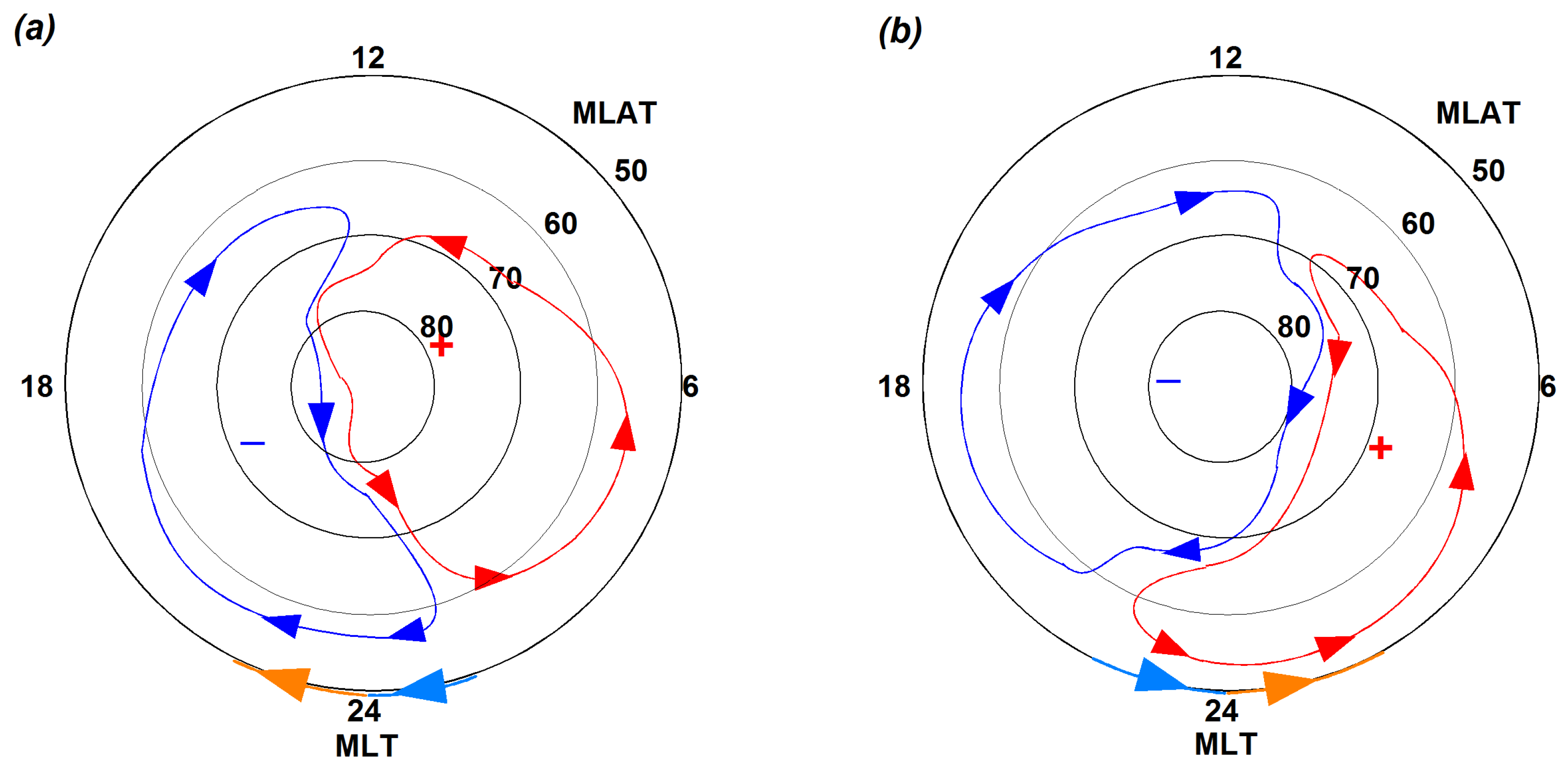
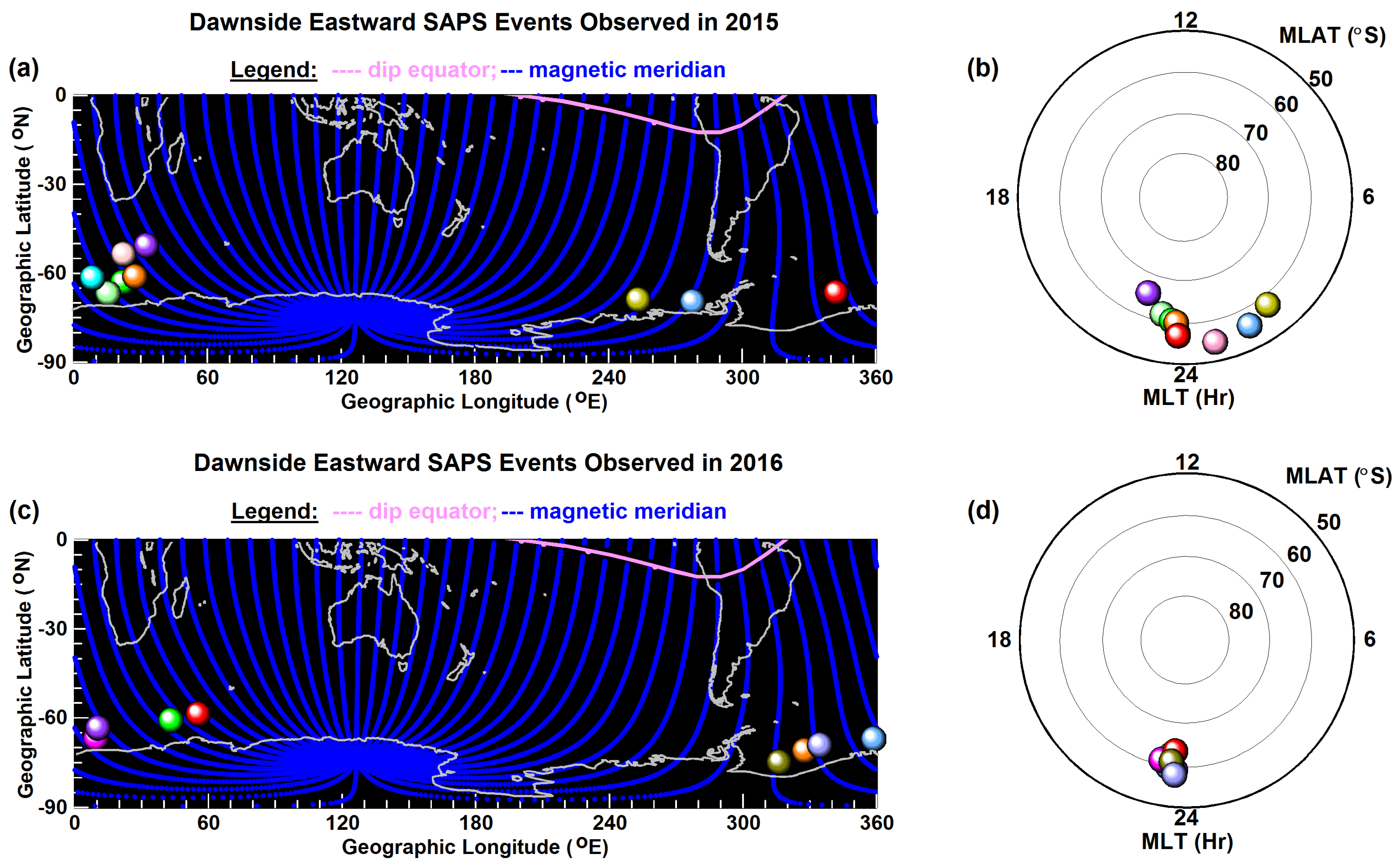

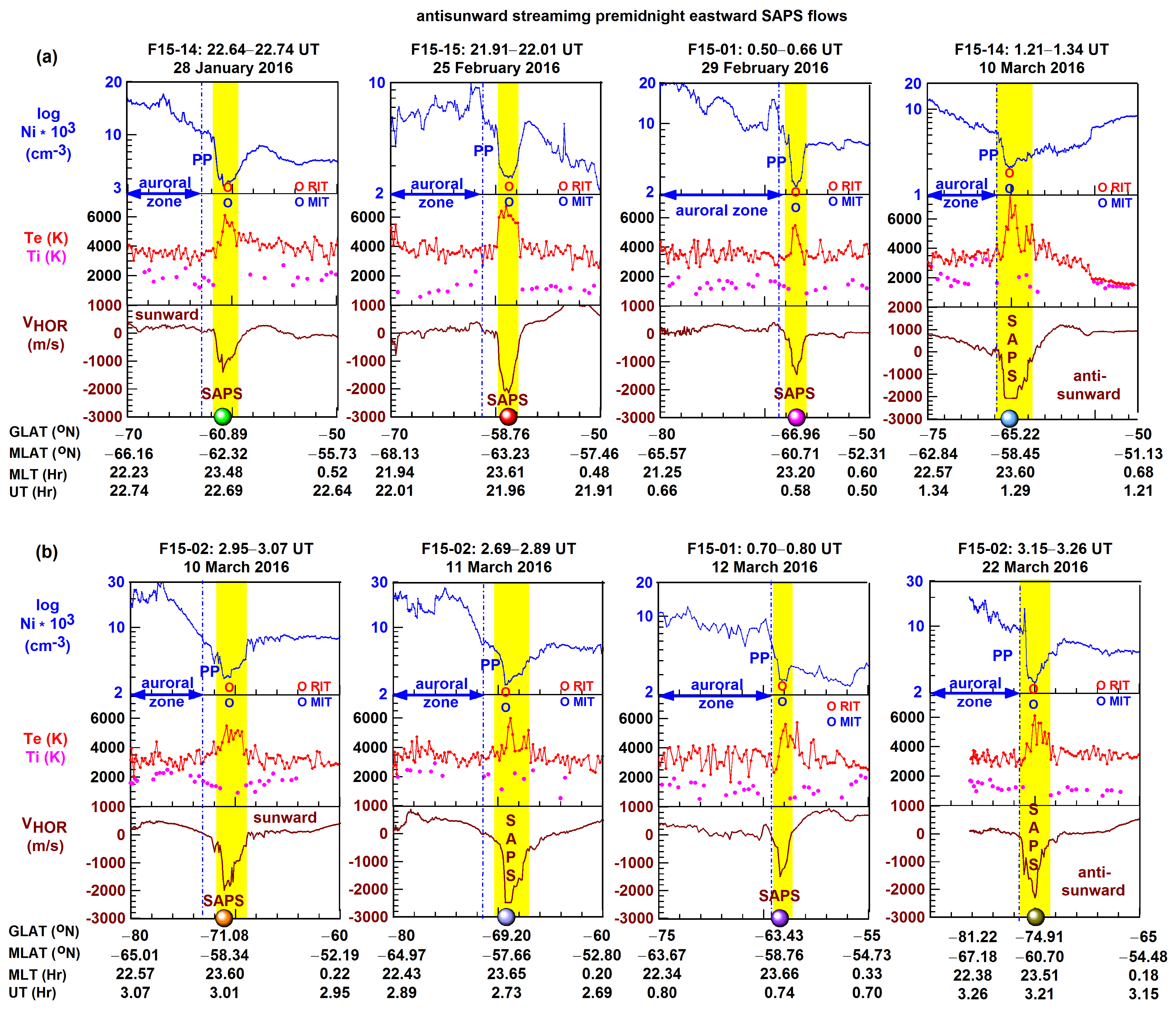
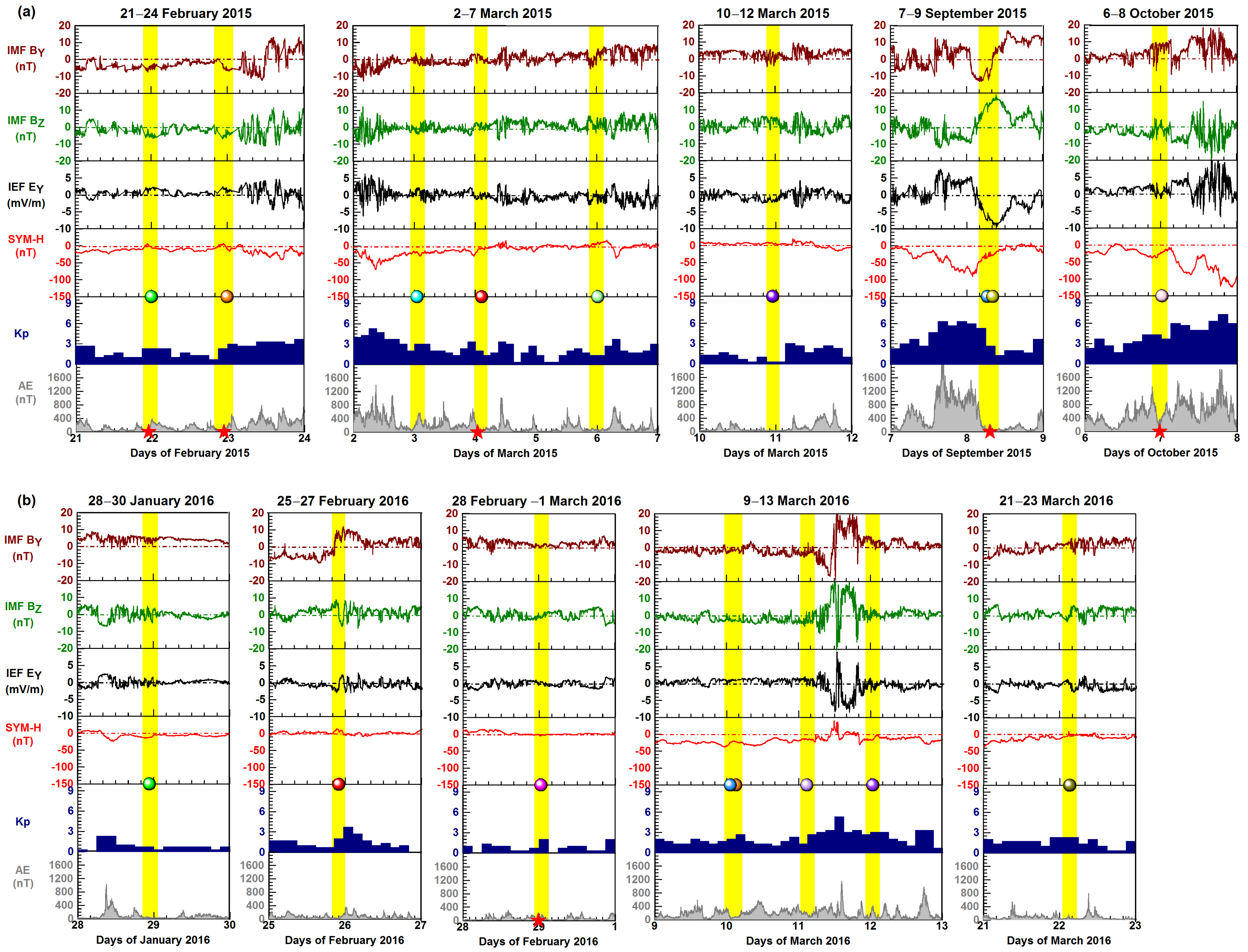
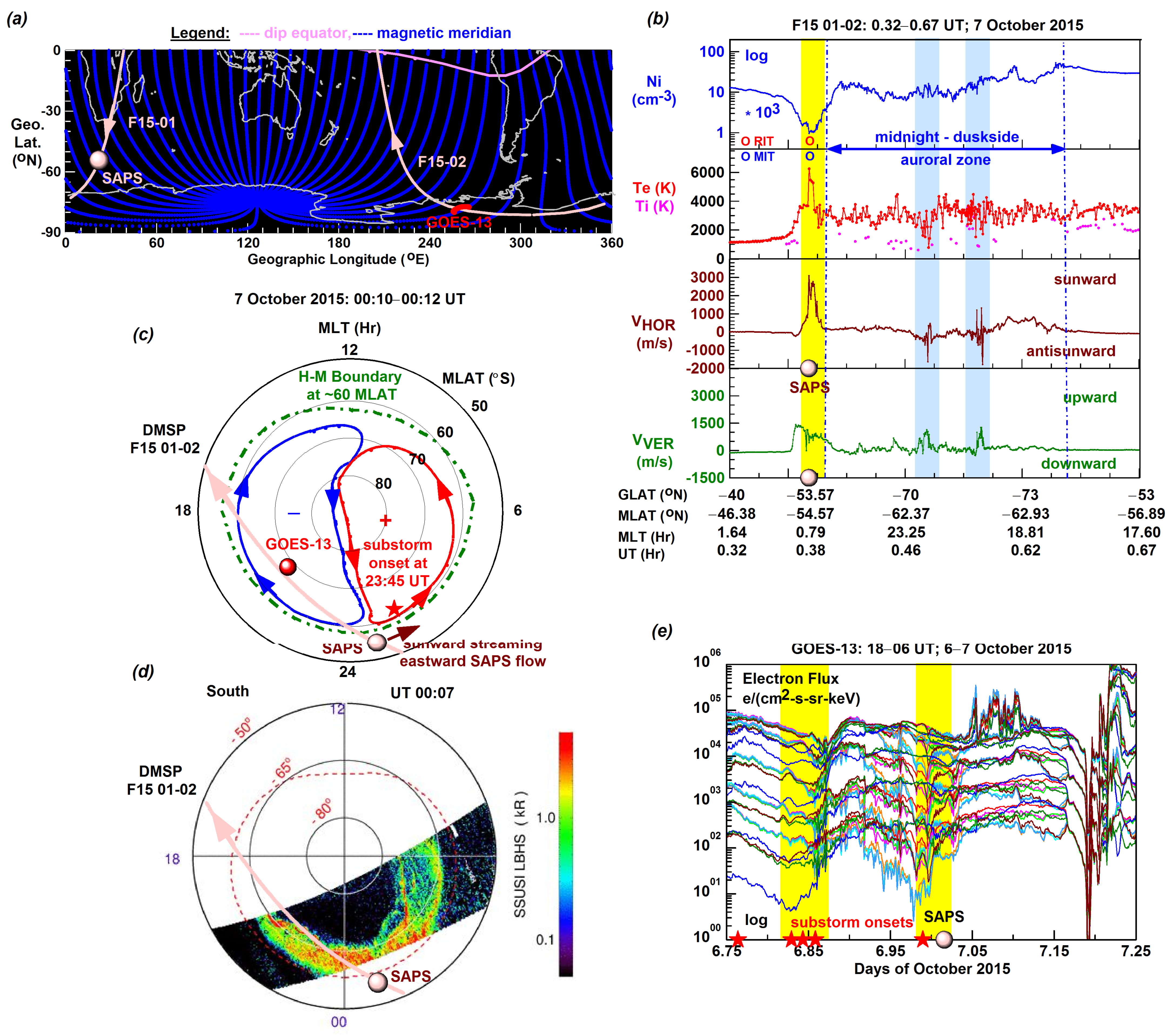
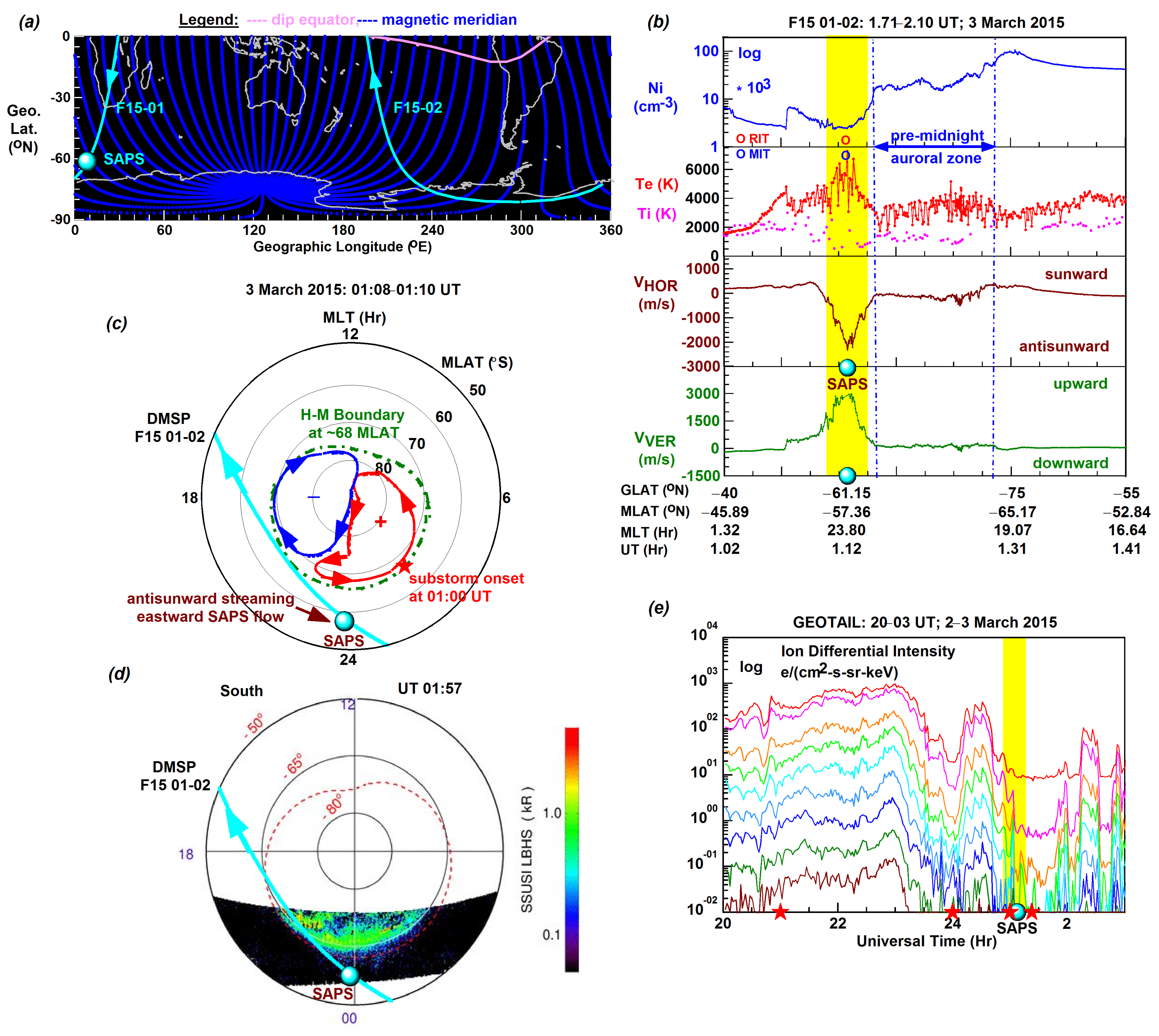
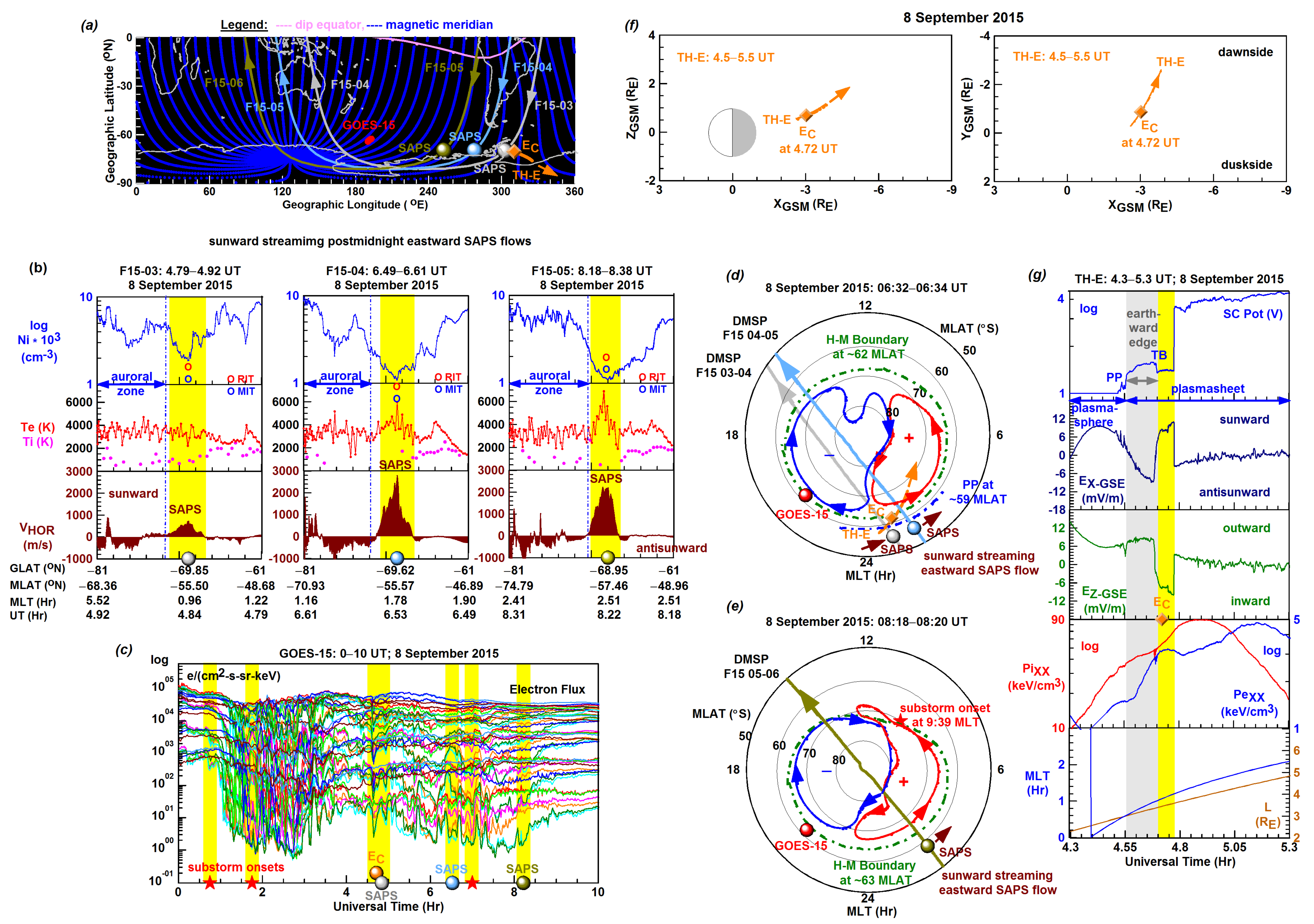
| Eastward SAPS Events | Plasma Variables | ||||||
|---|---|---|---|---|---|---|---|
| Event Number | Event Date | UT (Hr:Mn) | MLAT (°S) | MLT (Hr:Mn) | Ne 103 (cm−3) | VHOR (m/s) | Te (K) |
| 1 | 22 February 2015 | 00:08 | 60.22 | 23:36 | 3.5 | −2200 | 5500 |
| 2 | 22 February 2015 | 23:52 | 59.88 | 23:45 | 2.8 | −2000 | 6600 |
| 3 | 3 March 2015 | 01:07 | 57.36 | 23:48 | 2.5 | −2600 | 7400 |
| 4 | 4 March 2015 | 02:34 | 56.76 | 23:48 | 3.5 | −1200 | 6400 |
| 5 | 6 March 2015 | 00:21 | 61.49 | 23:17 | 3.2 | −1300 | 6000 |
| 6 | 10 March 2015 | 23:12 | 65.45 | 22:36 | 2.5 | −3100 | 7000 |
| 7 | 8 September 2015 | 06:32 | 55.57 | 01:47 | 1.1 | +2800 | 6000 |
| 8 | 8 September 2015 | 08:13 | 57.46 | 02:30 | 1.1 | +2200 | 7000 |
| 9 | 7 October 2015 | 00:23 | 54.57 | 00:47 | 1.0 | +3200 | 6400 |
| 10 | 28 January 2016 | 22:41 | 62.32 | 23:29 | 3.5 | −1400 | 6100 |
| 11 | 25 February 2016 | 21:57 | 63.23 | 23:37 | 2.8 | −2000 | 6700 |
| 12 | 29 February 2016 | 00:35 | 60.71 | 23:12 | 2.5 | −1400 | 5500 |
| 13 | 10 March 2016 | 01:17 | 58.48 | 23:36 | 2.1 | −2000 | 7500 |
| 14 | 10 March 2016 | 03:06 | 58.34 | 23:36 | 3.0 | −2000 | 5500 |
| 15 | 11 March 2016 | 02:44 | 57.66 | 23:39 | 2.5 | −2500 | 6000 |
| 16 | 12 March 2016 | 00:45 | 58.76 | 23:40 | 2.8 | −1500 | 5800 |
| 17 | 22 March 2016 | 03:13 | 60.70 | 23:30 | 2.5 | −2200 | 6400 |
| Eastward SAPS Events | IMF (nT) | SYM-H (nT) | Kp | AE (nT) | Substorm Onsets | |||
| Date | UT (Hr:Mn) | BY | BZ | UT (Hr:Mn) | MLT (Hr) | |||
| 22 February 2015 | 00:08 | −5.26 | −4.41 | −18 | 2+ | 230 | 23:10 # | 1.28 |
| 22 February 2015 | 23:52 | −6.48 | −4.43 | −8 | 4− | 171 | 23:34 ♦ | 1.29 |
| 3 March 2015 | 01:07 | 0.37 | −3.00 | −18 | 3 | 282 | 00:06 *# | 1.76 |
| 4 March 2015 | 02:34 | 1.34 | 2.72 | −7 | 2 | 43 | 00:54 * | 0.21 |
| 6 March 2015 | 00:21 | 3.86 | 2.86 | −1.20 | 1+ | 79 | - | - |
| 10 March 2015 | 23:12 | 3.58 | 3.51 | 5 | 3 | 33 | - | - |
| 8 September 2015 | 06:32 | −6.20 | 13.47 | −34 | 3− | 29 | - | - |
| 8 September 2015 | 08:13 | 0.80 | 15.32 | −27 | 3− | 36 | 07:02 * | 9.39 |
| 7 October 2015 | 20:57 | 4.48 | −5.8 | −105 | 7+ | 634 | 20:07 # | 7.71 |
| 28 January 2016 | 22:41 | 3.67 | 0.97 | −13 | 1− | 26 | - | - |
| 25 February 2016 | 21:57 | 8.20 | 4.42 | 5 | 2 | 42 | - | - |
| 10 March 2016 | 01:17 | −1.55 | −2.42 | −23 | 2 | 39 | 00:12 * | 1.31 |
| 10 March 2016 | 03:06 | - | - | −22 | 3− | 75 | - | - |
| 11 March 2016 | 02:44 | −4.54 | 1.97 | −14 | 1+ | 208 | 00:29 * | 2.48 |
| 12 March 2016 | 00:45 | −4.34 | −3.44 | −17 | 3 | 243 | 00:13 ♦ | 1.81 |
| 22 March 2016 | 03:13 | 0.45 | −3.65 | −16 | 2+ | 107 | 02:47 # | 0.57 |
Disclaimer/Publisher’s Note: The statements, opinions and data contained in all publications are solely those of the individual author(s) and contributor(s) and not of MDPI and/or the editor(s). MDPI and/or the editor(s) disclaim responsibility for any injury to people or property resulting from any ideas, methods, instructions or products referred to in the content. |
© 2025 by the authors. Licensee MDPI, Basel, Switzerland. This article is an open access article distributed under the terms and conditions of the Creative Commons Attribution (CC BY) license (https://creativecommons.org/licenses/by/4.0/).
Share and Cite
Horvath, I.; Lovell, B.C. Amplified Eastward SAPS Flows Observed in the Topside Ionosphere near Magnetic Midnight. Atmosphere 2025, 16, 1076. https://doi.org/10.3390/atmos16091076
Horvath I, Lovell BC. Amplified Eastward SAPS Flows Observed in the Topside Ionosphere near Magnetic Midnight. Atmosphere. 2025; 16(9):1076. https://doi.org/10.3390/atmos16091076
Chicago/Turabian StyleHorvath, Ildiko, and Brian C. Lovell. 2025. "Amplified Eastward SAPS Flows Observed in the Topside Ionosphere near Magnetic Midnight" Atmosphere 16, no. 9: 1076. https://doi.org/10.3390/atmos16091076
APA StyleHorvath, I., & Lovell, B. C. (2025). Amplified Eastward SAPS Flows Observed in the Topside Ionosphere near Magnetic Midnight. Atmosphere, 16(9), 1076. https://doi.org/10.3390/atmos16091076







